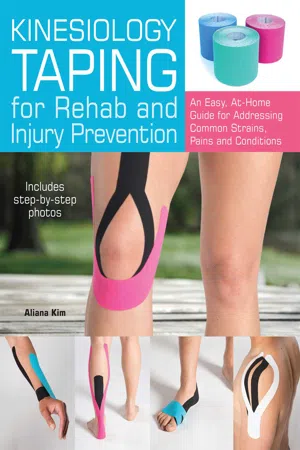
eBook - ePub
Available until 4 Dec |Learn more
Kinesiology Taping for Rehab and Injury Prevention
An Easy, At-Home Guide for Overcoming Common Strains, Pains and Conditions
- 112 pages
- English
- ePUB (mobile friendly)
- Available on iOS & Android
eBook - ePub
Available until 4 Dec |Learn more
Kinesiology Taping for Rehab and Injury Prevention
An Easy, At-Home Guide for Overcoming Common Strains, Pains and Conditions
About this book
THE ULTIMATE DIY TAPING GUIDE OF EVERYDAY INJURIES AND AILMENTS INCLUDES OVER 200 STEP-BY-STEP PHOTOS
Widely used by physical therapists, chiropractors and personal trainers, kinesiology tape provides incredible support while simultaneously stretching so your body can perform its normal range of motion. Now you can utilize this amazing material at home. Simply buy a roll at your local drugstore and follow the taping methods described in this book to reduce pain, rehab an injury and get back in the game.
Providing clear step-by-step instructions and helpful photos, the author shows how to tape the most common injuries and conditions anywhere on the body:
• Neck pain
• Frozen shoulder
• Bicep strain
• Tennis elbow
• Wrist sprain
• Tight IT band
• ACL/MCL sprains
• Achilles tendinitis
• Ankle sprain
• Plantar fasciitis
Widely used by physical therapists, chiropractors and personal trainers, kinesiology tape provides incredible support while simultaneously stretching so your body can perform its normal range of motion. Now you can utilize this amazing material at home. Simply buy a roll at your local drugstore and follow the taping methods described in this book to reduce pain, rehab an injury and get back in the game.
Providing clear step-by-step instructions and helpful photos, the author shows how to tape the most common injuries and conditions anywhere on the body:
• Neck pain
• Frozen shoulder
• Bicep strain
• Tennis elbow
• Wrist sprain
• Tight IT band
• ACL/MCL sprains
• Achilles tendinitis
• Ankle sprain
• Plantar fasciitis
Frequently asked questions
Yes, you can cancel anytime from the Subscription tab in your account settings on the Perlego website. Your subscription will stay active until the end of your current billing period. Learn how to cancel your subscription.
At the moment all of our mobile-responsive ePub books are available to download via the app. Most of our PDFs are also available to download and we're working on making the final remaining ones downloadable now. Learn more here.
Perlego offers two plans: Essential and Complete
- Essential is ideal for learners and professionals who enjoy exploring a wide range of subjects. Access the Essential Library with 800,000+ trusted titles and best-sellers across business, personal growth, and the humanities. Includes unlimited reading time and Standard Read Aloud voice.
- Complete: Perfect for advanced learners and researchers needing full, unrestricted access. Unlock 1.4M+ books across hundreds of subjects, including academic and specialized titles. The Complete Plan also includes advanced features like Premium Read Aloud and Research Assistant.
We are an online textbook subscription service, where you can get access to an entire online library for less than the price of a single book per month. With over 1 million books across 1000+ topics, we’ve got you covered! Learn more here.
Look out for the read-aloud symbol on your next book to see if you can listen to it. The read-aloud tool reads text aloud for you, highlighting the text as it is being read. You can pause it, speed it up and slow it down. Learn more here.
Yes! You can use the Perlego app on both iOS or Android devices to read anytime, anywhere — even offline. Perfect for commutes or when you’re on the go.
Please note we cannot support devices running on iOS 13 and Android 7 or earlier. Learn more about using the app.
Please note we cannot support devices running on iOS 13 and Android 7 or earlier. Learn more about using the app.
Yes, you can access Kinesiology Taping for Rehab and Injury Prevention by Aliana Kim in PDF and/or ePUB format, as well as other popular books in Medicine & Anesthesiology & Pain Management. We have over one million books available in our catalogue for you to explore.
Information
In order to perform kinesiology taping on yourself, there are a few terms you need to know. In this chapter, we’ll go over basic anatomy and kinesiology terms that will help you on your journey to self-taping.
It’s important to know what exactly kinesiology taping is. Kinesiology taping falls under a separate modality in the rehabilitative fields, similar to the Graston Technique. In most cases, in order to be certified in kinesiology taping, an individual must undergo three stages of training and then take a test offered through Kinesio Taping Association International (KTAI). The tape is meant to enhance the physiological systems of the body in regard to superficial tissue. The purpose of the tape is to prolong any manual therapy that a person has received in that the tape can be worn for up to five days. This has since evolved. Now taping has been used to prevent injury by helping the body stay in a structurally safe position during exercise or competition. It can also alleviate pain if an individual is going through competition slightly injured. As you’ll see in the next few chapters, with certain issues kinesiology taping can help with inflammation while simultaneously keeping the area stable and controlling some of the pain.
ANATOMICAL TERMS
Think of this as a rough sketch of anatomical terms you’ll see throughout this book. Anatomical terms tell us direction in regard to the body. Instead of using words like “left,” “right,” “up,” or “down,” these terms are more specific and will make taping easier to learn. You can always check back to this section if you need a refresher during the taping process.
Anatomical position is when the body is standing erect, toes forward, arms by your sides, and palms facing the same direction as the head (forward).
Positions
Supine position refers to a person lying on their back, with the face facing upward. The prone position refers to a person lying on their stomach, face facing down.

Supine position

Prone position
Planes of Motion
Some of these have an “alternate” term, but these are the most commonly used. The sagittal plane runs vertically and divides the body into left and right halves. The frontal (coronal) plane runs vertically and divides the body into front and back portions. The transverse plane runs parallel and divides the body into upper and lower portions.

Planes of motion
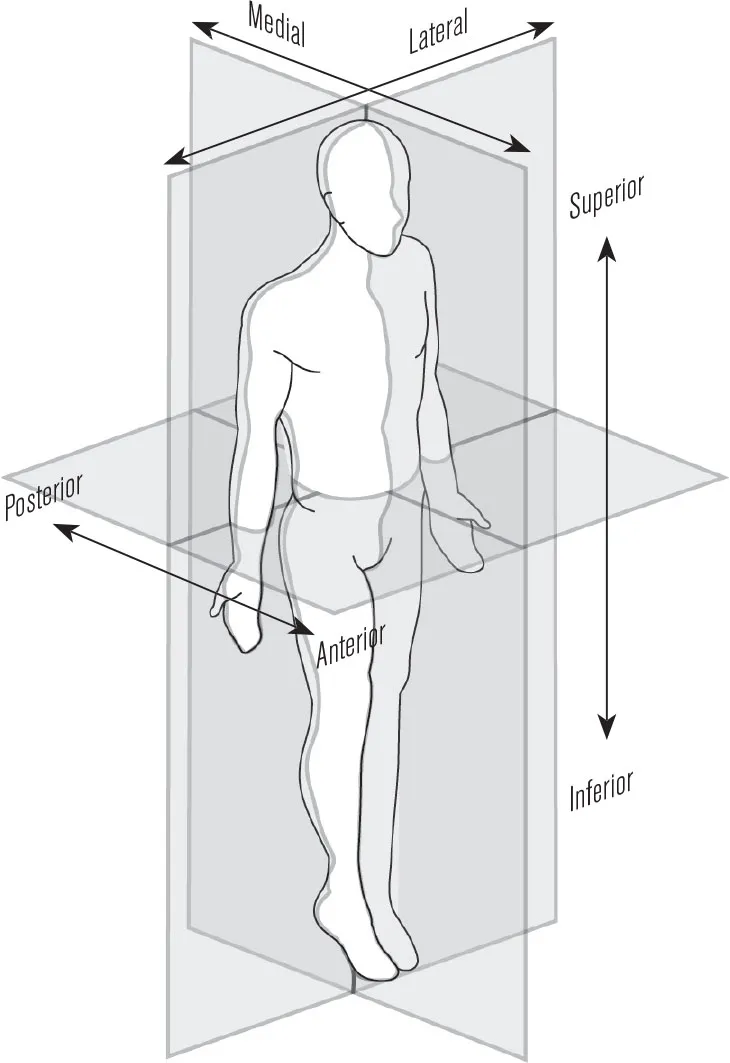
Directions and positions
Directions & Positions
As you use this book as reference, it’s important to understand directions and positions when it comes to the body. When you tape, you’ll constantly use terms such as adduction, abduction, superior, inferior, and others. These exact terms make it easier for us to identify where tape needs to go. When we say “adduction,” we know we want to bring the structure closer to the body. Using proper terms shortens what we have to say in the long run versus saying a mouthful to try to figure out where the structure is in conjunction to what you’re trying to tape. Being exact, in any rehabilitative field, is important. We don’t want to guess; we want to be 100% sure.
Superior means structures near the head region, usually synonymous with the term “cephalic.” Inferior is usually synonymous with the word “caudal,” which refers to structures near the tail, so think lower body. Posterior means back, and anterior means front. If you split the body using the frontal plane, this will give you reference to posterior and anterior positions and structures. Medial means structures near the midline of the body while lateral means structures away from the midline (think appendages). If you split the body by the sagittal plane, this will give you reference to structures that are medial or lateral. Closer to the center cut means the structure is medial. Farther away from the center cut means the structure is more lateral. These two terms are normally in reference to appendages and the axial skeleton.
Movements
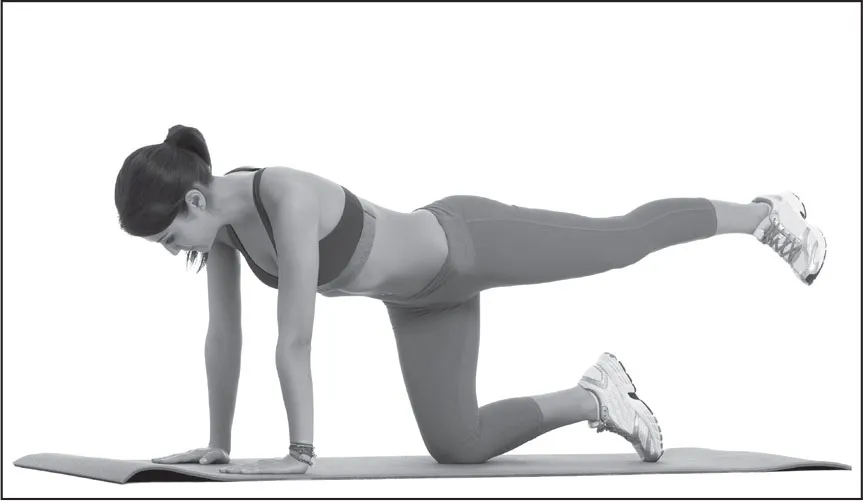
Extension
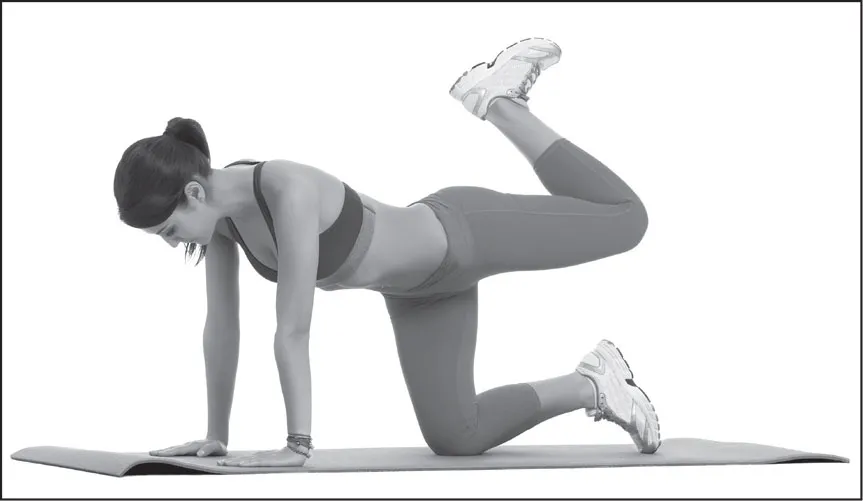
Flexion
These terms are probably the most important and the most used when you start taping. Extension straightens or opens a joint. Flexion bends a joint or brings bones closer together. Adduction brings limbs closer to the midline (think “add”—add to the body). Abduction moves limbs away from the midline.

Adduction/Abduction

Rotation
Rotation refers to the axial skeleton and usually happens along the transverse plane. Think of when you look left to right with your head. Supination is a pivoting action of the forearm, such as when your palms turn up to hold a bowl of soup. Pronation is when the palms face down toward the ground.
Inversion and eversion are movements associated with the feet. Inversion pulls the soles of the feet medially. Eversion essentially turns the feet outward and the soles of the feet are lateral. Plantar flexion and dorsiflexion refer to ankle movements. Plantar flexion moves the ankle so that the toes push toward the ground. Dorsiflexion moves the ankle so that the toes are pulled away from the ground (toes up).

Supination

Pronation
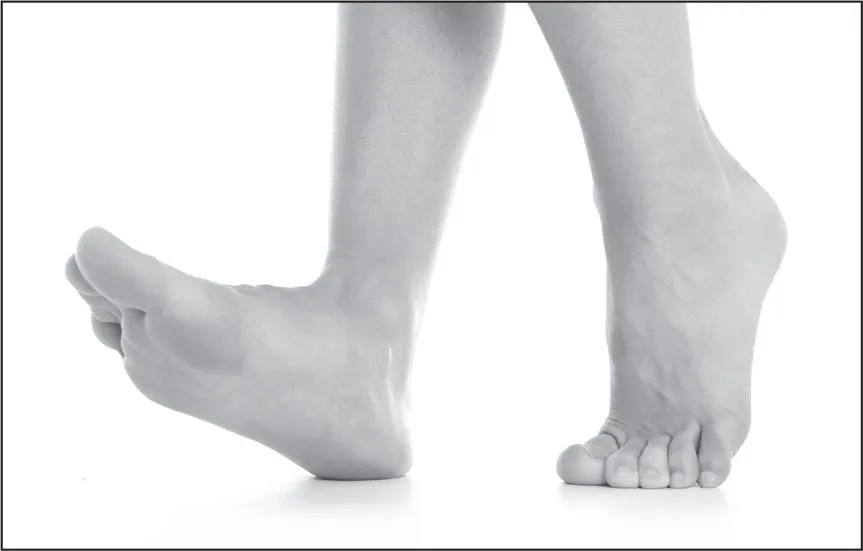
Dorsiflexion (left) and plantar flexion (right).
Muscles
The body has three types of muscle tissue: smooth, cardiac, and skeletal. Smooth muscle is found in our digestive tract while cardiac muscle is found in the heart. Skeletal muscle is connected to our skeletal system and is what makes us move. In this book, we focus solely on skeletal muscle.
When we look at skeletal muscle tissue, it is good to look at it in layers. The epimysium, or outer layer, wraps the entire muscle; it’s what incorporates our fascia. (Fascia is a thin, connective sheet; muscular fascia separates individual muscles and muscle groups in the body.) The middle layer, known as the perimysium, covers each bundle of muscle fibers, or fascicle. The deeper layer, called the endomysium, surrounds each individual muscle fiber. Each muscle comes together at the tendon. The tendon attaches the muscle to a bone structure, which gives us the ability to move.
While you are examining the body with your hands during treatment (the palpation process), be aware that when skeletal muscle is not contracted, it has a fairly soft feel, which can make it slightly difficult to find certain landmarks. If you contract the muscle so it has a firm, solid feel, it will be easier to find origin and insertion points.
Muscles that usually have the most discomfort include:
HAMSTRING GROUP: Three muscles, located in the back of the upper leg, make up the hamstrings: the biceps femoris, semitendinosus, and semimembranosus. The hamstrings perform certain actions that help with mobility, such as flexing the knee, extending the hip, laterally and medially rotating the hip, and tilting the pelvis posteriorly (toward the back). Common exercises that use the hamstrings are deadlifts, squats, and lower body plyometrics.
QUADRICEPS GROUP: The quadriceps group is one of the more massive muscles in the body. If you look at any bodybuilder, you will notice that this group of muscles tends to be quite large and defined. The quadriceps group consists of four muscles—the rectus femoris, vastus medialis, vastus lateralis, and vastus intermedius, which are mainly used in knee extension. Movements that develop the quadriceps group are leg extensions, lunges, Bulgarian split squats, and power squats.
GASTROCNEMIUS AND SOLEUS: The gastrocnemius and soleus are what make up your calf. The gastrocnemius is the most superficial, while the soleus is deeper than the gastrocnemius. The gastrocnemius has two muscular heads, which gives it a heart-like look when flexed. Located beneath the gastrocnemius, the soleus is an extremely strong muscle because during contr...
Table of contents
- Cover
- Title Page
- Dedication
- What Is Kinesiology Taping?
- Chapter 1: Basic Terms
- Chapter 2: Before You Begin
- Chapter 3: Basic Kinesiology Techniques
- Chapter 4: Face & Neck
- Chapter 5: Shoulder & Chest
- Chapter 6: Back & Trunk
- Chapter 7: Arms & Hands
- Chapter 8: Leg & Buttocks
- Chapter 9: Foot
- Acknowledgments
- About the Author
- Resources
- Bibliography
- Index
- Copyright